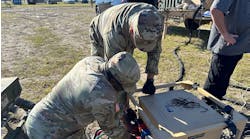The United States Air Force (USAF) will celebrate the completion of a new microgrid on Saturday when officials host a ribbon-cutting ceremony at Yokota Air Base in Japan.
The base’s new 10.72-MW combined heat and power (CHP) microgrid is part of a $406 million infrastructure improvement project that also includes energy and water saving efforts. The completed project will modernize the energy resilience and security of the base, which is located roughly 30 miles outside of Tokyo and is a critical part of the U.S. military’s operations in the Pacific.
Schneider Electric began construction on the project in 2021.
The microgrid is capable of powering the entire base during an outage, enabling Yokota to disconnect, or island, from the utility grid with no impact on base operations. During normal operations, the microgrid’s controller allows the base to optimize its energy use, lowering costs and reducing emissions.
The Yokota Air Base project joins a growing list of U.S. military bases with microgrid installations, including Marine Corps Air Station Miramar, White Sands Missile Range and Kirtland Air Force Base.
“We are proud to partner with the U.S. Air Force in their efforts to enhance mission readiness through energy assurance, working alongside the Yokota Air Base team to implement new technologies and system upgrades that will dramatically improve efficiency, resiliency and environmental responsibility,” said Annette Clayton, CEO of Schneider Electric North America.
No upfront investment required
The microgrid was developed and implemented by Schneider Electric under a 25-year self-funding energy savings performance contract (ESPC), which required no upfront investment from the base or American taxpayers. The energy savings provided by the new system will cover the cost of the contract over its life cycle.
It is expected that the CHP-driven microgrid will save the base $12.3 million a year and reduce carbon dioxide emissions by 33,000 metric tons annually, according to a release from Schneider Electric.
The US military is increasingly using ESPCs to develop microgrids in support of its energy resilience goals.
This is the sixth ESPC project that Schneider Electric has completed for the USAF over the last five years. Noresco and Ameresco have also been awarded ESPCs from the Air Force and Navy in recent years.
“ESPCs solve several challenges for our military: They make defense facilities more resilient to outages and secure from threats, while also helping to improve efficiency — all through a coordinated set of solutions,” said James Potach, senior vice president of energy and sustainability services at Schneider Electric.
Other base system improvements maximize savings
In addition to the new CHP plant and Schneider’s EcoStruxure microgrid controls and software, other system and building upgrades were made on the base as a part of the project.
Yokota’s energy management control system was upgraded to optimize mechanical, electrical and building systems across the base.
Additionally, more than 450 buildings were upgraded to reduce energy consumption by 75 million kWh per year and water consumption by 30 million gallons per year. Energy efficient LED lighting was installed across the base in addition to water conservation systems.
These efforts are expected to reduce the base’s annual energy and water costs by nearly 30%, according to Schneider Electric.
“The Yokota Air Base project is a great example of how to leverage traditional conservation measures in an ESPC and generate savings to fund resilience gaps identified in the Air Force governance process. This fence-to-fence holistic approach bundles lower payback opportunities with higher cost resilience requirements for critical missions to maximize the benefit for the installation,” said Mike Ringenberg, United States Department of the Air Force, ESPC/UESC SME and program manager.
Track military microgrid projects. Subscribe to the free Microgrid Knowledge Newsletter.








